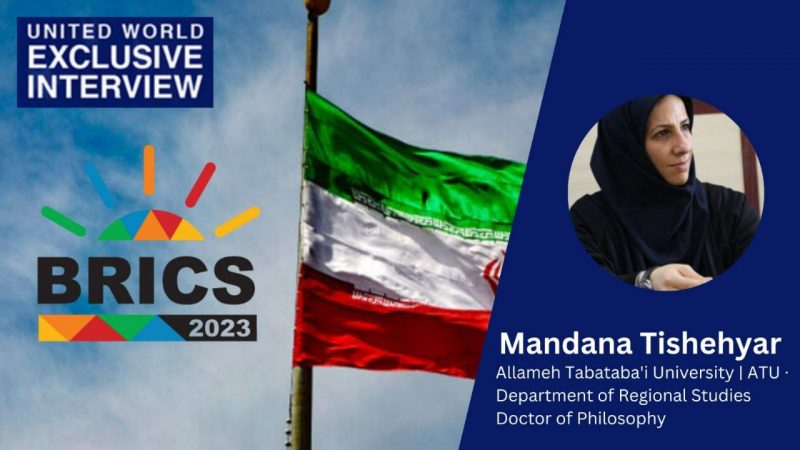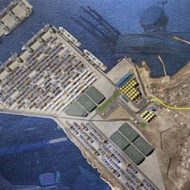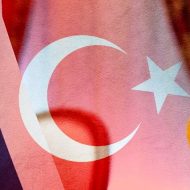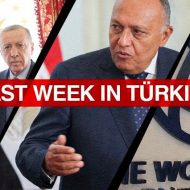BRICS’s its fifteenth summit in Johannesburg on August 22-24 came to the fore worldwide.
The position of BRICS in a multipolar world and an alternative reserve currency to the dollar were the most discussed topics.
And at the Summit, Iran, Saudi Arabia, United Arab Emirates, Argentina, Egypt and Ethiopia were set to enter BRICS from Jan. 1, 2024.
Thus, Iran is on its way to meet Saudi Arabia in BRICS after talks mediated by China.
We conducted an extensive interview with Mandana Tishehyar on Iran’s BRICS policy.
Mandana Tishehyar is a faculty member at the Department of Regional Studies, ECO College in Allameh Tabataba’i University, Tehran, Iran. She holds a PhD from Jawaharlal Nehru University, New Delhi.
Iran joining BRICS
We observe that Iran has been getting closer to the BRICS recently. In the last meeting of BRICS Iran has been invited to the membership. What are the reasons for this situation?
There are new international trends emerging that are leading to a greater role for certain political entities. Owing to unfair economic sanctions in recent years, Iran has been unable to enact an effective role in international organizations. However, due to its territorial specificities, Iran has always garnered attention from global powers. Serving as a vast bridge between Asia and Europe, along with Türkiye, Iran is rich in energy resources and connects two major energy hubs in the north-south corridor, namely the Persian Gulf and the Caspian Sea. Iran’s cultural and civilizational ties with its neighboring regions have further elevated its importance and status. Additionally, Iran’s large and youthful population, as well as its substantial consumer markets, present valuable economic cooperation prospects for other countries. Consequently, Iran has been selected to join BRICS.
Sanctions on Iran
Iran has long struggled with US sanctions and embargoes. It is known that this situation affects Iran’s economy badly. Considering that the BRICS has a significant economic power, is the BRICS an alternative for Iran against the US’ economic pressure?
According to Western officials, the economic sanctions on Iran are considered the most severe sanctions against a state in history. In recent decades, Iran has attempted to protest these conditions by challenging the hegemonic approach in the international order and seek ways to alleviate the impact of these sanctions. Through bilateral cooperation with other countries, especially its neighbors, and the development of new mechanisms to continue international economic activities, Iran has managed to sustain its economy, albeit with challenges. Accordingly, Iran’s collaboration with BRICS, as an international economic institution, aims to find a solution for alleviating the pressures caused by these economic sanctions.
“BRICS economy”?
Is BRICS just a model of economic cooperation for Iran? Or does BRICS have a political and national security significance for Iran? What are these points, if any?
Today, the economic and security interests of a country are closely intertwined with its political interests and approaches. Iran is fully aware of the diverse approaches of BRICS members to regional and international issues. Hence, it is unrealistic to expect such an economic entity to take a political stance on global events and trends. At least at this point in time, BRICS does not prioritize this objective. Nevertheless, enhancing cooperation and economic interactions between Iran and other major global powers within the framework of BRICS can undeniably bolster Iran’s interests and national security. Furthermore, it can provide the country with the opportunity to assume a more influential role on the international stage.
Iran and Saudi Arabia
Another country invited to the membership is Saudi Arabia. Considering the recent negotiations that China mediated, would the rapprochement of the two countries to BRICS contribute to the solution of the problems between Iran and Saudi Arabia?
Iran and Saudi Arabia are significant regional powers in West Asia. In recent months, both countries have made efforts to reduce tensions and establish new areas of cooperation at bilateral, regional, and international levels. It is important to note that each country has regional allies, so the improvement of relations between Iran and Saudi Arabia could have a transformative effect on the entire region. In addition to their membership in BRICS, which serves as a foundation for their international cooperation, it is worth mentioning that Iran has recently become a member of the Shanghai Cooperation Organization, while Saudi Arabia has applied for membership in this regional organization. Consequently, we can anticipate the emergence of new cooperation patterns within the framework of regional and international institutions as a result of Iran and Saudi Arabia’s partnerships. China’s efforts in March 2023 to enhance relations between Iran and Saudi Arabia can also be better understood in light of these developments. Furthermore, the presence of four major energy-producing powers – Iran, Saudi Arabia, Russia, and the United Arab Emirates – in BRICS can bolster the role of this international economic organization in shaping global energy policies in the future.
“Unipolarity coming to an end”
Considering the population and economic power of the countries included in BRICS, it has been argued for a long time that BRICS is an organization against the unipolar world order of the US. How does Iran view the BRICS in terms of multipolarity?
The era of polarization appears to be coming to an end. Since the nineteenth century, we have witnessed the rise of multipolar, bipolar, and unipolar worlds. During each of these periods, superpowers have formed alliances, uniting smaller nations and establishing hierarchical systems to shape the global order. However, we are now entering a post-polar era. In today’s world, countries are no longer aligning based on ideological beliefs; instead, their cooperation is driven by shared interests. Only in a post-polar world, countries like India can interact with both China and Russia in organizations like BRICS and the Shanghai Cooperation Organization, while also maintaining close ties with the US and Europe. What brings BRICS members together is their shared interests. Although it has challenged the US hegemony, the primary motivation for the formation of BRICS has not been to bring about the challenge. Looking ahead, we can anticipate a shift away from the formation of military, economic, or security alliances towards the creation of new regions. Within these regions, powers with varying levels of development will interact and cooperate in a mutually beneficial manner, with a less hierarchical, top-down structure. Considering the relative sense assumed by the word “region”, future regions will not be defined solely by geography, but rather by new shared interests and identities that nations and governments establish with one another. BRICS serves as a prime example of an economic region whose member states, despite being in Asia, Africa, and Latin America, have successfully defined shared interests and a new collective identity.
Variety of currencies instead of the dollar
What is Iran’s approach to an alternative exchange money instead of the dollar?
In recent decades, Iran has consistently emphasized in its foreign policy the rejection of superpowers’ dominance. This dominance can manifest in political, military, economic, and cultural forms. The preservation of countries’ independence and the promotion of fair relations between political entities have always been emphasized by Iran’s foreign relations policymakers. However, Iran is not the sole country following this approach, particularly in the realm of international political economy. Presently, India is engaging in economic cooperation with 17 countries worldwide, utilizing its own currency, the rupee. China has also initiated the use of the yuan for economic transactions. Likewise, Russia is endeavoring to decrease its economic reliance on the dollar, particularly since the onset of the Ukraine crisis. Consequently, a notable characteristic of the future economic landscape may be the variety of currencies employed in trade between nations.








Leave a Reply